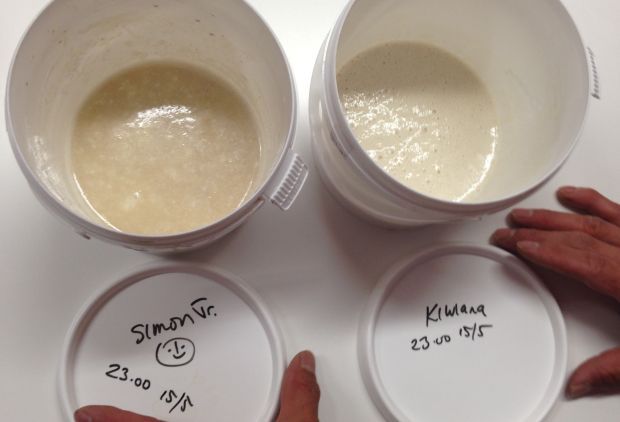Getting started and making a sourdough starter
The basic concepts of fermenting flour and water to make tasty bread
Neville advised that I use a sourdough starter created from his original starter created eight years ago using certified organic white flour and artesian water.
Once the starter is made all I then have to do is feed and maintain with organic white flour and water... (sounds simple...)

A wild starter called Simon Jr. and another starter made from Neville’s dried mother starter. Neville made these to illustrate the difference between using a ‘wild’ or an existing starter. Neville said for a newbie like me it’s best to start with a vigorous starter that has some pedigree.
Neville’s tips on revitalising a dried or living starter
Use artesian water as it's a pure natural untreated (no chemicals) water free from micro-organisms and organic substances. Alternatively, use filtered or bottled water to feed and maintain your mother starter.
Ensure the container, kitchen tools and bench are clean and you have washed your hands. Use a 1-2 litre container with fitted lid.
Day 1: Fill container with 200ml water. Add all of the dried starter from the sachet. Let sit covered for a few hours to soften. Then add 140g of white flour. Stir to combine, cover and let sit for 24 hours at room temperature and away from sunlight.
Day 2: Add 100ml water and stir. Then add 70g of white flour and stir to combine. The mixture will have the consistency of a thick batter. Cover and let sit for 24 hours at room temperature.
Day 3: You may see some signs of fermentation. Add 100ml water and stir. Then add 70g of white flour and stir to combine. Cover and let sit for 24 hours at room temperature.
Day 4: You will most likely see good fermentation (bubbling on surface). This is indication the sourdough culture has revitalised and is active. Retain 50g of the starter and throw the balance away. With the retained amount add 100ml water and stir. Then add 70g of white flour and stir to combine. Cover and let sit for 24 hours at room temperature.
Day 5: You will see good fermentation. It will smell wheaty and sweet. Taste some. It will be fizzy, slightly acidic, creamy and wheaty tasting. The sourdough starter is ready for you to make sourdough bread.
You will have approx. 220g of active sourdough. This is now your mother starter. You always keep 50g of it to feed and bulk up again (as per day 2-3). You take from it and feed back to maintain.
Maintaining a mother starter
Your active mother starter is best stored in the fridge in-between bakes. Once you have taken the amount you need for your pre-ferment, retain 50g of mother starter and feed it with 100g water/70g white flour. Let sit at room temp for 1-2 hours then put into the fridge for up to 7-10 days.
The mother starter will still be slightly active in the fridge, but of course at much slower rate.
From the fridge, let it come back to room temp naturally. Then feed with 100g water/70g flour. Let sit for 12-24 hours. It will be fully active and ready to use for making more pre-ferment.
Extra tips for creating your mother starter
Keep in mind different brands of flours available in NZ absorb water differently so your initial mix might be too watery or too thick, which inhibits fermentation activity.
The goal is to have a mixture that is pancake batter like. Not too thick, not too thin.
So this may mean you need to add a LITTLE bit more/less flour or water to achieve the consistency.
The mother starter responds to a good whipping, so whenever you incorporate new food into it (water/flour) don¹t be scared to give it a vigorous stir up to incorporate the ingredients. This incorporates oxygen into the batter which helps to stimulate the wild yeasts.
If after the first day and second day of mixing there is no fermentation activity and a thin layer of water on top, that¹s an indication the batter is too hydrated (wet). However, don¹t tip out the water, just give the mixture a real good whipping up with a soft tip spatula in the morning and carry on feeding to schedule in the evening. Increase the flour amount slightly (say from 70g to 90g).
Sometimes the starter will kick in a day or two later, so just keep in mind to ensure the mother starter has strong signs of fermentation on day 4 before you reduce it to 50g. There are no issues with carrying on an extra day or so before reducing down to 50g.

